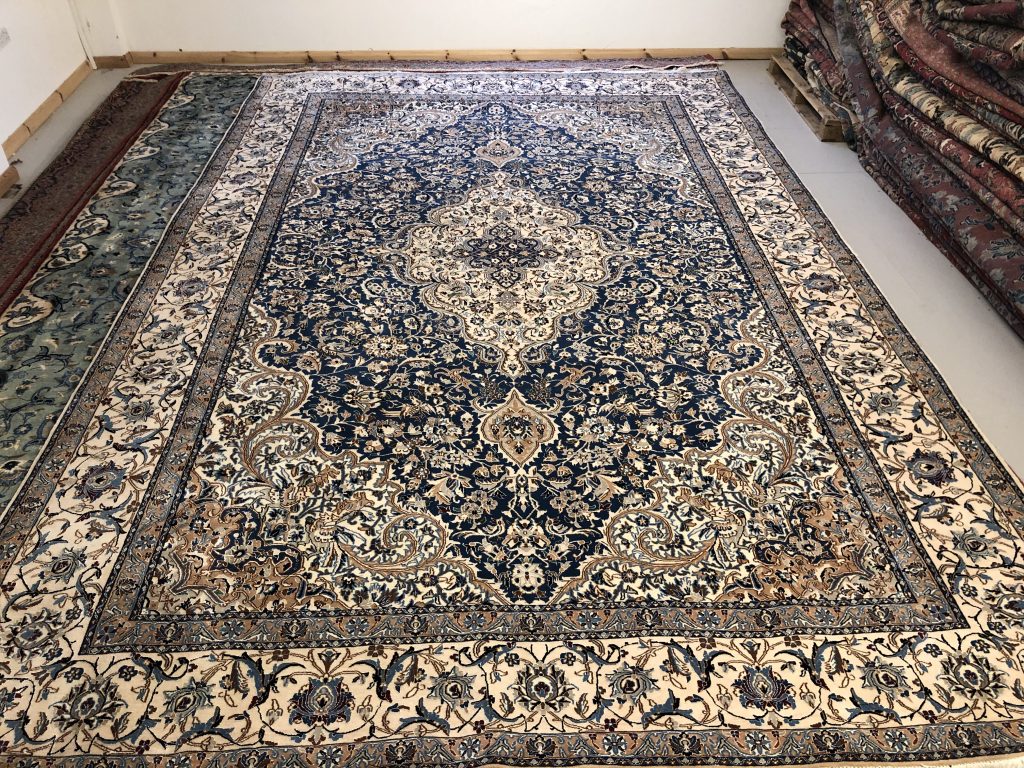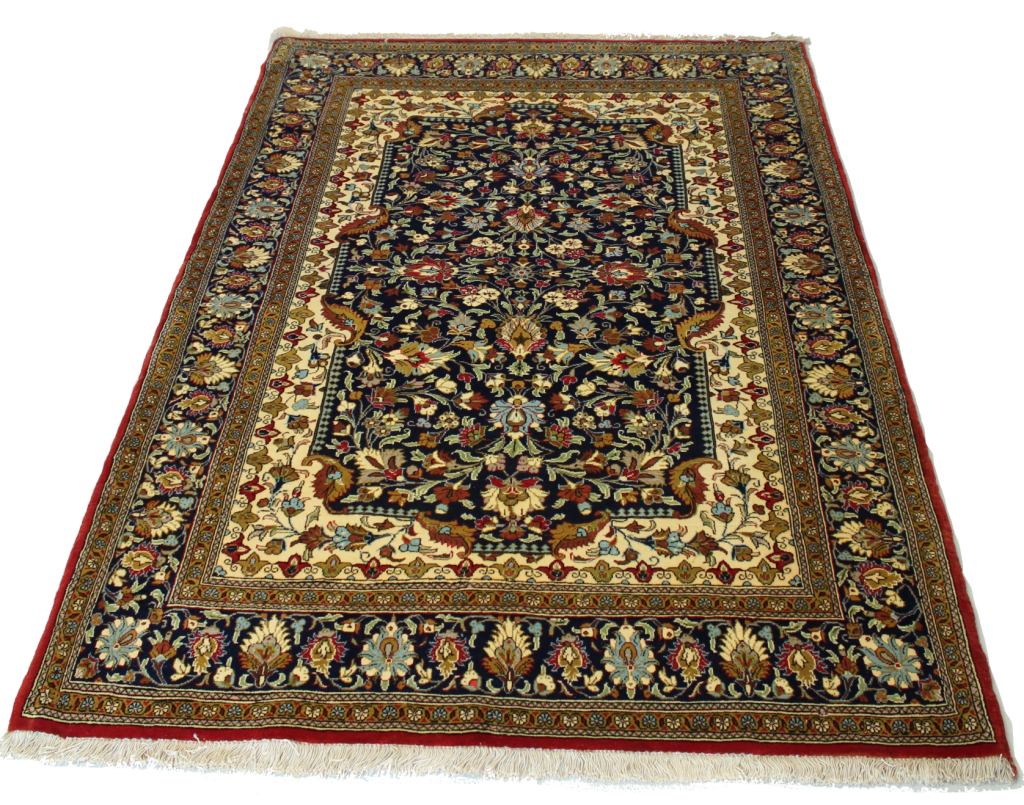A few tips and pointers on interior design with oriental rugs!
Trying out a rug at home
Bringing a few rugs home to try out has distinct advantages. You can examine the rug in detail in an unpressured environment. You can examine the rug under day light and artificial light. You will truly see how the rug fits in with your décor and lifestyle. The appearance of a handmade Oriental rug will usually enhance, and be enhanced by, its surroundings. You will no longer be looking at the rug as one of many in the showroom, instead, you will be seeing it with your own furniture and accessories. Something wonderful happens when a rug arrives in a new home. The right rug will take your breath away.
Ideally start a room from the rug
It is best to buy an Oriental rug before anything else in the room. There are infinitely more paint colours, wallpaper patterns and fabrics available than there are handmade oriental rugs. Building the room around the elements in the oriental rug can often yield spectacular results. Pick three favourite colours from the rug and work that into the paint, fabric and plants. The results are absolutely phenomenal, every single time.
The right size rug
There are no strict rules on rug size and room size. The aim is for the rug is to work with, rather than against your furniture. A variety of different sizes will suit a particular room. The first step is to determine the floor space. Ideally, if you were to present us with a scaled floor plan that shows placement and size of all the furniture in a room; the floorplan will practically shout out what size rug you should have. A floor plan should include accurate dimension of the entire room, not just part of the room, interesting features such as fire place and bay windows, and sizes of the larges furniture (sofa, bookshelf) should be noted. This will allow you to tackle the size issue with a master plan.
Oriental rugs are not meant to cover the floor completely. If you want the oriental rug to cover most of the room, it is best to leave 18-24 inches of bare floor on all four sides. The bare floor space acts as a frame for the rug. By the way, the depth of the average piece of upholstered furniture is 32 inches.
This basic scheme of determining the right size can vary slightly to accommodate distinctive features, such as a fireplace. If a fireplace with a hearth extends into the room, then the rug can be brought flush against it or close to it, leaving an 18-24 inch margin on the opposite side of the room. This helps from distorting the room’s proportions. After all, if the fireplace were on the long side of the room, and you had left 18-24 inches between the fireplace and the rug, then you will have to choose a narrower rug, which accentuates the length of the room. Don’t worry about the danger of sparks, the wool in the pile of a rug doesn’t burn that easily.
Many large rooms have several distinct functions. Rugs are often used to define the area. For example, two different rugs can set off a dining area from a living area, or a study area with a desk from an entertaining area with sofa and chairs.
The shape of a rug can change the proportions of a room. Long runners and rectangular rugs can lengthen a room, while two different rugs can shorten or subdivide the same space. You could use a rug to direct flow of traffic of a room. For example, walking over the fringed end and along the length of a rug seems to direct people to a particular area, while walking directly across a rug may make your guests hesitate. This factor is especially important in the entrance hall, where careless placement of a rug could lead visitors in the wrong direction, who might end on up in the kitchen as opposed to the living room.
The function of the room and the rug
The dining room rug doesn’t need to be any larger than the space required for the dining table and chairs to pull out comfortably. It will serve as a plate for the table and chairs to sit on. Dining room rug must be quite durable to withstand the heavy wear from constantly moving/pushing chairs away from the table. Especially since such stress tends to focus on particular spots on the rug.
The bedroom rug is much more tricky to select as the bed may hide a great deal of the carpet. Sometimes, it is better to use a number of small pieces around the furniture in a bedroom, but to also offer enough coverage to avoid bare feet touching the bare floor! Larger bedrooms with little furniture can usually accommodate large rugs that brings the room together.
Staircase rug makes any staircase absolutely strikingly beautiful. The rug’s patterns take on a wonderful look when they are seen from such a different perspective. Be sure to buy a very good quality carpet for your staircase and have the nap facing down, so you will not be going ‘against the grain’ or against the pile when walking on the steps. This will ensure the rug stands up to all the traffic it will be getting.
Study rug or library rug, any area where people will be spending a lot of time, should be sturdy. Merely walking across a rug does not cause as much damage as sitting in a particular area and digging in the heels of your shoes. Do not tempt to buy something inexpensive for a high-traffic area. Your initial outlay of a better quality rug may be higher, but it will last much longer and improve with age.
Needs of a rug
The edges of the rugs are their weakest parts. They should not be exposed to constant use. That is, a rug should not end within an arch or a doorway, nor should there be bare floor between a rug and a piece of furniture that is used for seating. If this happens, the edge of the rug will wear prematurely, and may also be a tripping hazard. Rugs also need to be reversed periodically to even out the use.
Colours of a rug
Your choice of colour will depend on the existing décor. Identify the basic tone of a given room of either cool or warm colours. A light rug enlarges a room, while a red one warms up the room. Also consider the practical side of choosing a rug. A pastel rug is lovely in a bedroom or a room that is not used a lot, but it would not be recommended to put such a rug in the most heavily travelled part of the living room or by the front door.
Design of a rug
Oriental rugs can blend with a variety of decorating styles, from traditional to mid-century to contemporary. There are no rules when it comes to which rug is best suited for which décor, however, a little common sense would be very helpful. For example, hiding a central medallion under a dining table or a bed is not as sensible as using an all-over design. If you like an uncluttered minimalist look and have not got a great deal of furniture, a medallion rug would be an ideal choice. A double niche medallion rug would echo traditional gilt framed pictures or silver photograph frames. A brightly colour kilim will bring out the bright colours in the fruit bowl in a white kitchen.



